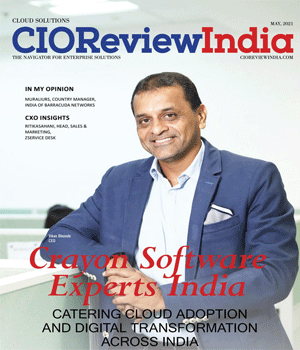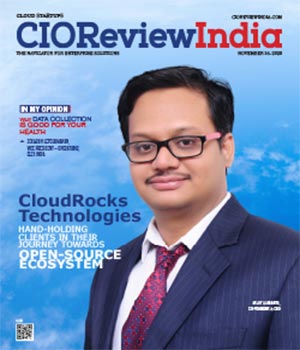
Instrument Of Technology Inclusion In Industries - High Performance Computing
Excerpts from an interaction with Manish Israni, Executive Vice President & CIO, Yotta | Tuesday, 08 September 2020, 12:00 IST
 In a recent interaction with Emmanuel Christi Das, Editor, CIOReviewIndia, Manish Israni, Executive Vice President & CIO, Yotta shares the disruptions caused by High Performance Computing (HPC), factors augmenting the growth of HPC and its future implementation.
In a recent interaction with Emmanuel Christi Das, Editor, CIOReviewIndia, Manish Israni, Executive Vice President & CIO, Yotta shares the disruptions caused by High Performance Computing (HPC), factors augmenting the growth of HPC and its future implementation.
Mention major innovations in the recent days in High Performance Computing.
The first thing that comes to mind when we say ‘High-Performance Computing’ is supercomputers. High-performance computing (HPC) has been used by researchers and scientists from many years to work on voluminous data and cull out insights. As there has been an exponential rise in the size and amount of data that companies have been working with, parallel computing has become more relevant and crucial for real-time processing.
It is seen that HPC users have been moving their workloads from in-house to public clouds. HPC users can extend their data with the help of services provided by large public cloud providers. They can also use cloud-based HPC solutions to integrate AI/ML to boost their performances.
Graphics Processing Unit is one of the main components of high-performance computing. GPUs have become very crucial for processing big data because of their sole focus on data computation. They are being utilized to work on data-intensive tasks such as machine learning. Google’s TPU (Tensor Processing Unit) is also used especially for machine learning. However, there has been an increase in demand for GPU and simultaneously, leading to a resultant increase in the supply-demand gap. As speed is key in high-performance computing, there has been a shift towards edge computing. Edge computing provides speedier interactions, removes latency, real-time processing, and is connected to the central data center. With the rise in movement of workloads, decentralizing the data storage through edge computing might take the center stage. Also Field Programmable Gate Arrays (FPGA) are one of the important components in the HPC ecosystem. They consume less power and deliver maximum processing performance per watt which is essential in a data center. Going with Intel investments in Altera, which grants us to see HPC and Cloud computing gains from FPGAs implementation.
What is the future of HPC in India?
The speed at which data is growing, nowadays, determines the rapid development of high-performance computing. As per the features of supercomputers -- the high-powered, high-performance computers -- the enormous capacity for problem-solving will benefit fast-tracking digitization. The future of high-performance computing is focused on efficiency, i.e. yielding more results with less provisions. It lies in climate modelling, biosciences, geographical data collection, and other factors. HPCs will also be helpful to live stream content all over the world and edit feature films.
Companies across various sectors like manufacturing, energy and utilities, healthcare, automobile, oil and gas, defense, to education, require dealing with complex problems and calculations. HPC solutions work with huge data quantities effortlessly and support high-performance data analysis efficiently. Additionally, High-Performance Computing-as-a-Service (HPCaaS) can provide for speedier data processing with high accuracy. These benefits offered by HPCaaS have further accelerated the adoption of these services across industry verticals.
According to you, what are the major advantages of HPC in SAP?
Businesses today are recognizing that a high-performance computing (HPC) infrastructure is vital to supporting the advanced analytics and simulated modelling applications of tomorrow. New data-intensive applications that utilize artificial intelligence, machine learning and data analytics all require high-performance computing resources and scalability to deliver the best results. With the usage of HPC in SAP environment, organizations are getting real-time analytics and live transaction awareness of their data.
Moreover, SAP’s enterprise software solutions require high-performance database operations and efficient solution of complex, exponential time-complexity combinatorial optimization problems, both of which can potentially be accelerated HPC.
The high-performance computing market is expected to witness a CAGR of 6.13% over the forecast period from 2020 to 2025. State the major factors contributing to this growth.
The advent of big data and complex applications such as ultra-high-definition workflows, electronic design automatic simulations, etc. across various industries has influenced the growth of high-performance computing market. AI has become mainstream, IoT devices have flooded the market; this has led to an increased requirement of faster processing, leading to increased adoption of HPCaaS. Machine learning is growing in public-centric services with enterprises investing in HPC technology. With the support of HPCaaS, organizations can receive efficient database management services with reduced cost. Industries such as defense, the government are availing HPC services to support real-time data acquisition, analyses and even disaster modelling, seamlessly. HPC in cloud enables scalability, flexibility, low maintenance costs and unlimited storage capacity, which is the need of the hour in today’s data-intensive world.
Mention a few useful HPC technologies that could enhance business processes.
HPC technologies can enhance a company’s value incredibly. The increased application of high-performance computers in government and scientific research departments has an irreplaceable role in expanding a country’s technological development. In addition, manufacturing, automobile, healthcare, and other industries can increase their productivity effectively. The Grid is a crucial development of HPC. Using an HPC as a host to a network structure to form a grid architecture, it will be advantageous to store all the data in a supercomputer.
HPC can help in detecting frauds and risk assessments as it can handle large volumes of data. This system can support digital forensic investigation and enhance data privacy. Large hospitals are using high-performance computing for medical research and speed up discoveries of new drugs. Medical professionals can also use its computing power to diagnose and identify a patient’s personalized treatments. The energy sector has been using high performance computers since many years in their search for accessible oil and gas deposits for seismic analysis.
The cloud has optimized the use of HPC for enterprises. It helped create a new category of cloud services - deep learning as a service. The manufacturing sector has also been making use of supercomputers to make real-time adjustments to enhance the product design based on IoT and big data analysis.
CIO Viewpoint
Unlocking the Potential of Cloud and AI: A...
By Pratik Jain, Lead Business Analyst – Digital Transformation, ACS Global Tech Solutions
Importance of Zero-Trust Cloud Security in the...
By Sameer Danave, Senior Director Marketing, MSys Technologies
The Transition to a Cloud-First World
By Kapil Makhija, Vice President -Technology Cloud, Oracle India
CXO Insights
AI Integration in Multi-Cloud and Edge...
By FaizShakir, VP & Managing Director – Sales, Nutanix
The Role of Hybrid Cloud in ERP Integration
By Swapnil Jugade, CIO, Revent Group
Cloud Sustainability and Its Role in a Greener...







.jpg)
.jpg)
.jpg)

.jpg)
.jpg)
.jpg)

.jpg)

.jpg)




